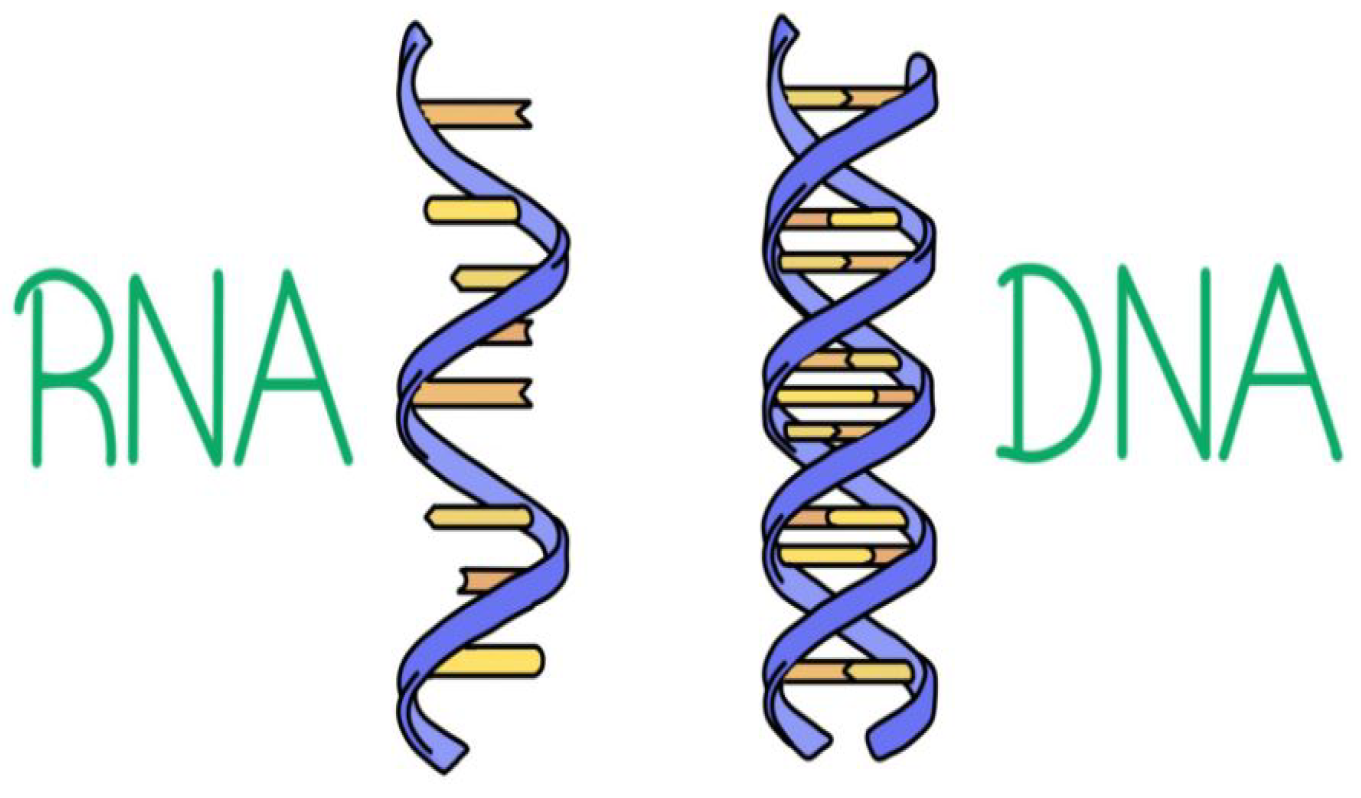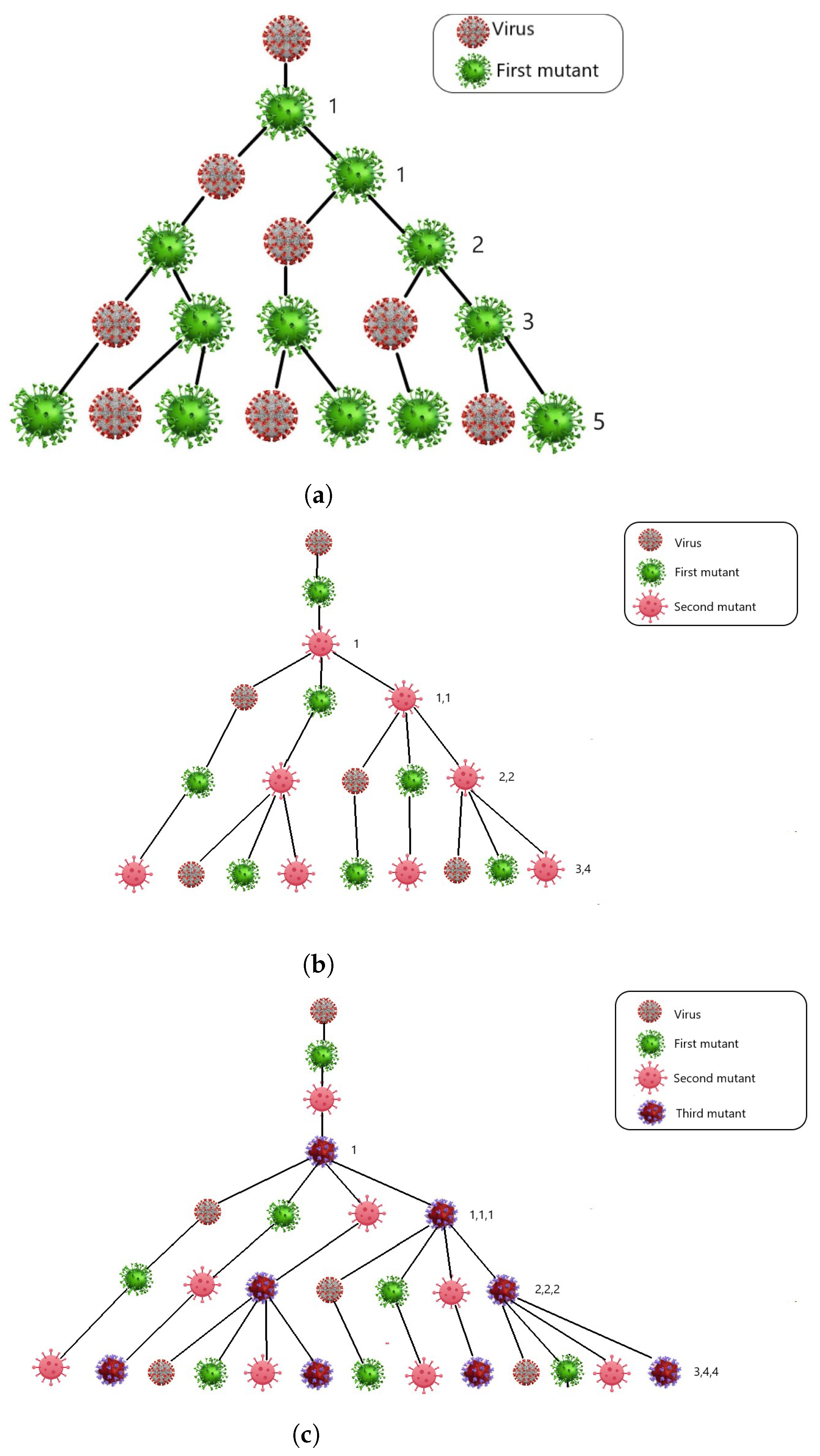Abstract
:1. Introduction
2. Basic Concepts of Fibonacci Sequence
3. Coefficients of the Generalized Fibonacci Equation
4. -Nacci Sequence: A Generalization
5. Golden Ratio for -Nacci Sequence
6. The Generalization of Other Fibonacci-like Sequence
7. Virus Mutation
8. Fibonacci Numbers in Virus Mutation
- (i)
- Generalized m-Fibonacci sequence:
- (ii)
- m-step Fibonacci sequence:
- (iii)
- -Nacci sequence:
9. Fibonacci Risk Modeling
9.1. Fibonacci Risk Formula
9.2. Criticality Risk Values
9.3. Activity Risk
9.4. Activity Risk Values
9.5. Risk Activity for Tribonacci Sequence
9.6. Risk Metrics
- (i)
- Reduce compression to 0.5: a risk of 0.5 is the optimal decompression target, since it aims to reduce the risk to its lowest possible level.
- (ii)
- Do not decompress too much: decompression above the decompression range has a negative value, and over-decompression increases the danger.
- (iii)
- Normal solutions should not exceed 0.75: if a risk of 0.3 is the lower bound for all solutions, then a risk of 0.75 is the upper bound for a normal solution. High-risk normal solutions should always be decompressed.
10. Conclusions
Author Contributions
Funding
Data Availability Statement
Acknowledgments
Conflicts of Interest
References
- Blankenship, R.A. The Golden Ratio and Fibonacci Sequence in Music. Ph.D. Thesis, Ohio Dominican University, Columbus, OH, USA, 2021. [Google Scholar]
- Debnath, L. A short history of the Fibonacci and golden numbers with their applications. Int. J. Math. Educ. Sci. Technol. 2011, 42, 337–367. [Google Scholar] [CrossRef]
- Dunlap, R.A. The Golden Ratio and Fibonacci Numbers; World Scientific: Singapore, 1997. [Google Scholar]
- Ilić, I.; Stefanović, M.; Sadiković, D. Mathematical Determination in Nature—The Golden Ratio. Acta Med. Median. 2018, 57, 124. [Google Scholar] [CrossRef]
- Letchumanan, S.; Idris, R. Application of fibonacci series, golden proportions and golden rectangle to human hand using statistical analysis. Univ. Malays. Teren. J. Undergrad. Res. 2020, 2, 31–40. [Google Scholar] [CrossRef]
- Grigas, A. The Fibonacci Sequence: Its History, Significance, and Manifestations in Nature. Ph.D. Thesis, Liberty University, Lynchburg, VA, USA, 2013. [Google Scholar]
- Kalman, D.; Mena, R. The Fibonacci numbers—Exposed. Math. Mag. 2003, 76, 167–181. [Google Scholar]
- García-Máynez, A.; Acosta, A.P. A method to construct Generalized Fibonacci Sequences. J. Appl. Math. 2016, 2016, 4971594. [Google Scholar] [CrossRef]
- Falcon, S. Generalized (k,r)-Fibonacci numbers. Gen. Math. Notes 2014, 25, 148–158. [Google Scholar] [CrossRef]
- Trojovský, P. On terms of generalized Fibonacci sequences which are powers of their indexes. Mathematics 2019, 7, 700. [Google Scholar] [CrossRef]
- Cohn, J.H. Square fibonacci numbers. In Exploring University Mathematics; Pergamon: Oxford, UK, 1967; pp. 69–82. [Google Scholar]
- Koshy, T. Fibonacci and Lucas Numbers with Applications; John Wiley & Sons: Hoboken, NJ, USA, 2019; Volume 2. [Google Scholar]
- Singh, B.; Sisodiya, K.; Ahmad, F. On the Products of k-Fibonacci Numbers and k-Lucas Numbers. Int. J. Math. Math. Sci. 2014, 2014, 505798. [Google Scholar] [CrossRef]
- Falcon, S.; Plaza, Á. The k-Fibonacci sequence and the Pascal 2-triangle. Chaos Solitons Fractals 2007, 33, 38–49. [Google Scholar] [CrossRef]
- Falcon, S.; Plaza, A. On k-Fibonacci numbers of arithmetic indexes. Appl. Math. Comput. 2009, 208, 180–185. [Google Scholar] [CrossRef]
- Holliday, S.H.; Komatsu, T. On the sum of reciprocal generalized Fibonacci numbers. Integers 2011, 11, 441–455. [Google Scholar] [CrossRef]
- Marques, D. On the spacing between terms of generalized Fibonacci sequences. Colloquium Mathematicum 2014, 2, 267–280. [Google Scholar] [CrossRef]
- Bravo, J.J.; Gómez, C.A.; Luca, F. On the distance between generalized Fibonacci numbers. Colloq. Math 2015, 140, 107–118. [Google Scholar] [CrossRef]
- Shannon, A.G.; Horadam, A.F. Generalized Fibonacci number triples. Am. Math. Mon. 1973, 80, 187–190. [Google Scholar] [CrossRef]
- Frontczak, R. Relations for generalized Fibonacci and Tribonacci sequences. Notes Number Theory Discret. Math. 2019, 25, 178–192. [Google Scholar] [CrossRef]
- Marques, D.; Togbé, A. Perfect powers among Fibonomial coefficients. Comptes Rendus Math. 2010, 348, 717–720. [Google Scholar] [CrossRef]
- Bacani, J.B.; Rabago, J.F.T. On generalized Fibonacci numbers. arXiv 2015, arXiv:1503.05305. [Google Scholar] [CrossRef]
- Luca, F.; Shorey, T.N. Diophantine equations with products of consecutive terms in Lucas sequences. J. Number Theory 2005, 114, 298–311. [Google Scholar] [CrossRef]
- Gu, A.; Xu, Y. The research of the generalized Fibonacci sequence-based propagation. Phys. Procedia 2012, 24, 1737–1741. [Google Scholar] [CrossRef]
- Dundar, F.S. COVID-19 and the fibonacci numbers. In Proceedings of the 9th International Eurasian Conference on Mathematical Sciences and Applications, Skopje, North Macedonia, 25–28 August 2020; p. 74. [Google Scholar]
- Persaud, D.; O’Leary, J.P. Fibonacci series, golden proportions, and the human biology. Austin J. Surg. 2015, 2, 1066. [Google Scholar]
- Dosal-Trujillo, L.A.; Galeana-Sánchez, H. The Fibonacci numbers of certain subgraphs of circulant graphs. AKCE Int. J. Graphs Comb. 2015, 12, 94–103. [Google Scholar] [CrossRef]
- Prodinger, H.; Tichy, R. Fibonacci numbers of graphs. Fibonacci Q. 1982, 20, 16–21. [Google Scholar]
- Szynal-Liana, A.; Włoch, I.; Liana, M. Some identities for generalized Fibonacci and Lucas numbers. AKCE Int. J. Graphs Comb. 2020, 17, 324–328. [Google Scholar] [CrossRef]
- Włoch, A. On generalized Fibonacci numbers and k-distance Kp-matchings in graphs. Discret. Appl. Math. 2012, 160, 1399–1405. [Google Scholar]
- Dasdemir, A. On the Pell, Pell-Lucas and modified Pell numbers by matrix method. Appl. Math. Sci. 2011, 5, 3173–3181. [Google Scholar]
- Catarino, P.; Campos, H. Incomplete k-Pell, k-Pell-Lucas and modi fied k-Pell numbers. Hacet. J. Math. Stat. 2017, 46, 361–372. [Google Scholar]
- Falcón, S. Binomial Transform of the Generalized k-Fibonacci Numbers. Commun. Math. Appl. 2019, 10, 643. [Google Scholar] [CrossRef]
- Kwon, Y. Binomial transforms of the modified k-Fibonacci-like sequence. arXiv 2018, arXiv:1804.08119. [Google Scholar]
- Leyendekkers, J.V.; Shannon, A.G. Primes within generalized Fibonacci sequences. Notes Number Theory Discret. Math. 2015, 21, 56–63. [Google Scholar]
- Noe, T.D.; Post, J.V. Primes in Fibonacci n-step and Lucas n-step sequences. J. Integer. Seq. 2005, 8, 4. [Google Scholar]
- Rexma Sherine, V.; Gerly, T.G.; Britto Antony Xavier, G.; Abisha, A. Comparative Analysis on Virus Mutation with Fibonacci Numbers. J. Comput. Math. 2023, 7, 61–72. [Google Scholar] [CrossRef]
- Singh, B.; Bhadouria, P.; Sikhwal, O.; Sisodiya, K. A formula for Tetranacci-like sequence. Gen. Math. Notes 2014, 20, 136–141. [Google Scholar]
- Soykan, Y. Summing formulas for generalized Tribonacci numbers. Univers. J. Math. Appl. 2020, 3, 1–11. [Google Scholar] [CrossRef]
- Soykan, Y. Binomial transform of the generalized Tribonacci sequence. Asian Res. J. Math. 2020, 16, 26–55. [Google Scholar] [CrossRef]
- Soykan, Y. On generalized Narayana numbers. Int. J. Adv. Appl. Math. Mech. 2020, 7, 43–56. [Google Scholar]
- Soykan, Y. A Study on Sum Formulas for Generalized Tetranacci Numbers: Closed Forms of the Sum Formulas kWk and kW−k. Asian J. Adv. Res. Rep. 2021, 15, 68–85. [Google Scholar] [CrossRef]
- Taşyurdu, Y. Binomial Transforms of Generalized Fibonacci-Like Sequences. Int. J. Math. Trends Technol.-IJMTT 2018, 64, 59–64. [Google Scholar] [CrossRef]
- Fibonacci Sequence. Available online: https://www.britannica.com/science/Fibonacci-number (accessed on 28 August 2024).
- University of California Museum of Paleontology. Evolution from a Virus’s View. December 2007. Available online: https://evolution.berkeley.edu/evo-news/evolution-from-a-viruss-view/ (accessed on 1 October 2018).
- CDC. Types of Influenza Viruses. Available online: https://www.cdc.gov/flu/about/viruses/types.htm (accessed on 30 March 2023).
- CDC. How the Flu Virus Can Change: Shift and Drift. Available online: https://www.cdc.gov/flu/about/viruses/change.htm (accessed on 12 December 2022).
- World Health Organization. Coronavirus Disease (COVID-19): Variants of SARS-COV-2, 20 November 2023. Available online: https://www.who.int/news-room/questions-and-answers/item/coronavirus-disease-(covid-19)-variants-of-sars-cov-2 (accessed on 20 November 2023).









| Name of the Sequence | Fibonacci | Tribonacci | Tetranacci | ⋯ |
|---|---|---|---|---|
| Generalization | ⋯ | |||
| Lucas | ⋯ | |||
| Pell | ⋯ | |||
| Pell–Lucas | ⋯ | |||
| Modified Pell | ⋯ | |||
| Jacobsthal | ⋯ | |||
| Jacobsthal–Lucas | ⋯ | |||
| Modified Jacobsthal | ⋯ | |||
| Jacobsthal–Perrin | ⋯ | |||
| Adjusted Jacobsthal | ⋯ | |||
| Modified Jacobsthal–Lucas | ⋯ | |||
| Narayana | ⋯ | |||
| Primes | ⋯ | |||
| Lucas-Primes | ⋯ | |||
| Modified Primes | ⋯ | |||
| Padovan–Perrin | ⋯ | |||
| ⋮ | ⋮ | ⋮ | ⋮ | ⋱ |
| For | List of Sequences | Golden Ratio |
|---|---|---|
| -Nacci Names | List of -Nacci Sequence | Golden Ratio |
|---|---|---|
| h-Fibonacci | ||
| h-Tribonacci | ||
| h-Tetranacci | ||
| h-Pentanacci | ||
| h-Hexanacci | ||
| h-Heptanacci | ||
| Parameters | Description |
|---|---|
| Low risk level activity | |
| Medium-Low risk level activity | |
| Medium risk level activity | |
| Medium-High risk level activity | |
| High risk (critical) level activity | |
| Number of Low risk activities | |
| Number of Medium-Low risk activities | |
| Number of Medium risk activities | |
| Number of Medium-High risk activities | |
| Number of High risk (critical) activities |
Disclaimer/Publisher’s Note: The statements, opinions and data contained in all publications are solely those of the individual author(s) and contributor(s) and not of MDPI and/or the editor(s). MDPI and/or the editor(s) disclaim responsibility for any injury to people or property resulting from any ideas, methods, instructions or products referred to in the content. |
© 2024 by the authors. Licensee MDPI, Basel, Switzerland. This article is an open access article distributed under the terms and conditions of the Creative Commons Attribution (CC BY) license (https://creativecommons.org/licenses/by/4.0/).
Share and Cite
Alhazmi, M.; Venchislas, R.S.; Gnanamuthu, G.T.; Perumal, C.; Hilali, S.O.; Alsaeedi, M.; Natarajan, A.; Gnanaprakasam, B.A.X.
Alhazmi M, Venchislas RS, Gnanamuthu GT, Perumal C, Hilali SO, Alsaeedi M, Natarajan A, Gnanaprakasam BAX.
Alhazmi, Muflih, Rexma Sherine Venchislas, Gerly Thaniel Gnanamuthu, Chellamani Perumal, Shreefa O. Hilali, Mashaer Alsaeedi, Avinash Natarajan, and Britto Antony Xavier Gnanaprakasam.
2024. "





